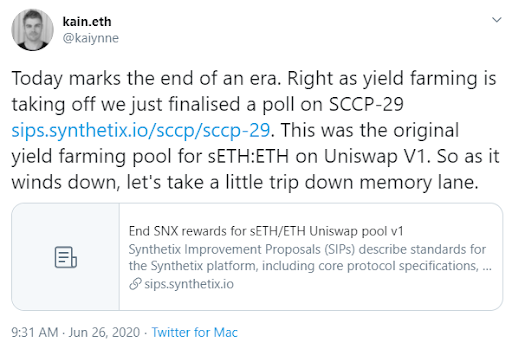
The latest craze in DeFi - yield farming: A Beginner's Guide
2020-09-01 | CryptoCurrency.ong
DeFi suporters have warmed up to the farming metaphor and memed into existence “yield farmers
DeFi supporters have warmed up to the farming metaphor and memed into existence “yield farmers” - the weapon of choice for folks who measure yield as the amount of interest that’s grown atop underlying crypto assets when they're in use in DeFi platforms like Compound.
Even if you are new to the crypto community, you’ve probably heard the term DeFi. Put simply, DeFi is a set of standard financial tools. These tools all have their foundation on the Ethereum blockchain. Since it is based on the blockchain, there is a level of anonymity that remains in each transaction. However, DeFi has taken on a whole new meaning in DeFi Yield Farming
What is it?
Yield farming is the act of leveraging different DeFi protocols and products to earn a yield or a return on their assets, in some cases obtaining profits well over 100% APY through a combination of lending interest and token incentives. In addition to the term “DeFi yield farming”, you might also see liquidity mining thrown around. You can use these terms interchangeably since they mean the same thing. Yield is used in relation to farming: on a farm, the measure of yield refers to the total amount of crop that’s grown. Yield farming has since been adopted to DeFi. As a result, it can be referred to as the amount of interest that’s grown on top of underlying crypto assets. This means investing in Ethereum (ETH) alone does not classify as yield farming. However, lending out your Ethereum to earn additional returns on top of the natural growth in the value of the Ethereum coin is yield farming. Additionally, yield farming will generate a higher rate of return. In some cases, this has amounted to over 100% of what an investor would earn in a classic savings account. This is possible since DeFi yield farming compounds returns by utilizing leverage to gain additional exposure to various crypto assets collateralized with USD-backed stablecoins. One of the ways to farm DeFi yields is through money markets.
How did it begin?
The Yield Farming frenzy started when Compound began the live distribution of COMP, its governance token, on June 14th. Compound reached more than $600M total value locked, and overtook MakerDAO for the first time ever on DeFi Pulse’s leaderboard, making it the #1 protocol in DeFi by this measure in a matter of days. However, COMP appears to have only been the beginning with Balancer having launched their protocol rewards incentive program in May started their live distribution a few days after Compound. Balancer experienced similar exponential growth, adding more than $70M TVL. Although the frenzy started with COMP, yield farming has been known and practiced in DeFi for some time now. Synthetix, for example, had introduced the concept of protocol token rewards in exchange for liquidity provision to the sETH/ETH pool on Uniswap V1 in July 2019.
(source: https://twitter.com/kaiynne/status/1276417760222797825)
Compound’s team proposed to update the system’s liquidity incentive one week after COMP distribution went live on June 27th. The proposal looked to discourage an inorganic demand for BAT and other assets since users were concentrating extreme liquidation risks into these markets. The new liquidity incentive proposal was executed on July 2nd. Currently, COMP is distributed proportionally across the markets that borrow more dollars, and not dollars of interest paid. Rewards continue to be distributed on a 50%-50% basis between suppliers and borrowers of a given market.
Strategies to make the most out of yield farming
- InstaDapp - to further increase user’s earnings, some yield farmers have decided to take out leveraged loans. These loans can then be used to borrow the tokens which yield the most COMP. This is because the 2880 COMP tokens that are issued each day are distributed to those with the most leverage. Therefore, more collateral to leverage means you will earn more free money.
- Balancer - the native token of Balancer is BAL. It can be earned when users provide liquidity to Balancer Pools. The contents of each pool can be reviewed and compared before adding liquidity. One reason for this currency’s popularity is that of 100 million BAL to be minted, 65 million have been allocated for liquidity provider rewards.
- Synthetix - A synthetic-asset protocol on Ethereum with similar yield-farming mechanics, Synthetix has also seen incredible growth. Their synthetic dollar sUSD has captured volume amidst the stablecoin explosion.
- Aave, UMA, and Curve - these are also set up to launch their own forms of yield farming, the first waves are to be expected soon.
Conclusion
Yield farming has exploded onto the DeFi scene and captured peoples’ imaginations. However, it’s not all fun and games, either. Yield farming is new and isn’t going anywhere, so there’s no need to rush in, so be curious, but don’t be reckless.
Enjoy reading? Please share:
Get the latest crypto news, updates and reports by subscribing to our free newsletter!








